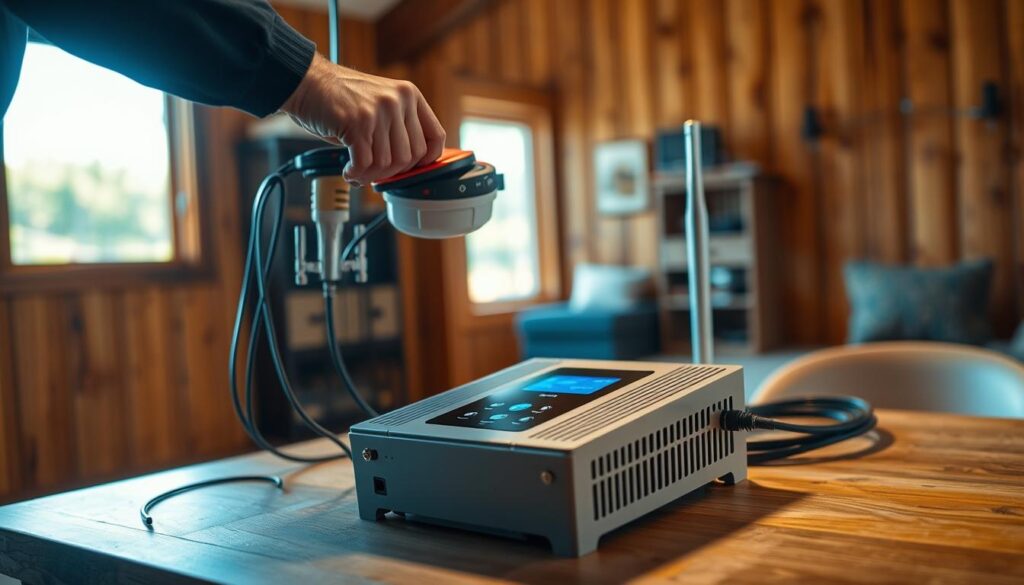Boost Your Cell Signal in Rural Locations

Living in rural areas, cabins, or remote farms has its perks. But, getting a good cell phone reception can be tough.
When cable or fiber internet is hard to find, cellular connectivity is key. It keeps you connected. Boosting your cell signal is vital for clear communication. And, there are good ways to do it.
I’ll look into ways to boost your cell signal, especially for rural locations. Whether you’re at home, on a farm, or in a cabin, a strong cell signal is possible.
Key Takeaways
- Understand the importance of cellular connectivity in rural areas.
- Learn about the available cell phone signal boosters.
- Discover the best options for homes, farms, and cabins.
- Improve your cell phone reception with the right solution.
- Stay connected with reliable cellular connectivity.
Understanding Rural Cell Signal Challenges
Rural cell signal challenges come from many angles. They include geography, infrastructure, and technology. These issues make it hard to keep a strong cell phone signal in rural spots.
Why Rural Areas Suffer from Poor Reception
Rural areas face poor cell reception mainly because of their distance from cell towers. Natural barriers like mountains and forests also play a big role. These obstacles make it tough to keep a reliable connection.
Key factors affecting signal strength include:
- Distance from cell towers
- Natural barriers like trees and mountains
- Building materials used in construction
How Distance and Terrain Affect Signal Quality
The distance to the nearest cell tower greatly affects signal quality. The farther you are, the weaker the signal. Terrain, like hills and mountains, can also block or weaken signals.
The Impact of Limited Cell Tower Infrastructure
In rural areas, there are fewer cell towers. This means weaker signals. The low population density makes it hard for carriers to invest in more towers.
| Factor | Impact on Signal |
|---|---|
| Distance from Cell Towers | Weaker signal with increased distance |
| Natural Barriers | Blocks or weakens signal |
| Limited Infrastructure | Less coverage, weaker signal |
Knowing these challenges helps us find ways to improve rural cell signal quality.
How Cell Phone Signal Boosters Work
It’s important to know how cell phone signal boosters work, especially in rural areas. These devices capture weak signals and make them stronger for better indoor coverage.
The Science Behind Signal Amplification
Signal amplification is what cell phone boosters do best. They use an outside antenna to grab cellular signals. Then, an amplifier makes these signals stronger.
The amplified signal is sent indoors by an inside antenna. This gives you a stronger and more reliable connection.
Essential Components: Outside Antenna, Amplifier, and Inside Antenna
A cell phone booster has three main parts: an outside antenna, an amplifier, and an inside antenna. The outside antenna picks up weak signals. The amplifier boosts these signals.
The inside antenna then sends the amplified signal indoors. For more info on how boosters work, check out Wilson Amplifiers’ blog.
Signal Strength Measurements: Understanding dB Ratings
Signal strength is measured in decibels (dB). Knowing dB ratings helps you pick the right signal booster. A higher dB rating means a stronger signal.
When picking a booster, look at its dB rating. A booster with a high dB rating can make weak signals stronger. This ensures reliable coverage.
Types of Cell Phone Boosters Available
There are many types of cell phone boosters for different needs. You can find them for vehicles, homes, or temporary use. It’s important to know what you need to choose the right one.
Vehicle-Mounted Boosters for Cars, Trucks, and RVs
Vehicle-mounted boosters are made for cars, trucks, and RVs. They give a strong signal while you’re on the move. These boosters have an external antenna, an amplifier, and an internal antenna.
They’re great for people who travel a lot or commute in rural areas.
Key features to look for in vehicle-mounted boosters include:
- Durability and weather resistance
- Easy installation
- Compatibility with your carrier
Home and Building Boosters: Single-Room vs. Multi-Room
Home and building boosters improve cell signal inside buildings. They come in single-room and multi-room types. Single-room boosters work well for small homes or offices. Multi-room boosters cover bigger areas, like multiple floors.
When choosing a home booster, consider:
- The size of the area you need to cover
- The number of users who will be using the booster
- The strength of the outside signal
Portable Signal Boosters for Temporary Solutions
Portable signal boosters are flexible for temporary needs. They’re small, easy to use, and can be taken anywhere. They’re great for outdoor events, camping, or as a backup in emergencies.
Key Factors to Consider When Choosing a Rural Signal Booster
Choosing the right rural signal booster is important. You need to think about a few key things. This will help you pick the best one for your needs.
Coverage Area Requirements: Square Footage Analysis
The size of the area you need to cover is key. Whether it’s a small cabin or a big farmhouse, the booster must fit your needs. Coverage area is usually measured in square feet.
Think about your property’s layout and how many rooms you need better signal in. A bigger area needs a stronger booster.
| Coverage Area (sq ft) | Typical Use Case | Recommended Booster Type |
|---|---|---|
| 0-5,000 | Small cabins or homes | Low to mid-range boosters |
| 5,000-10,000 | Medium-sized homes or offices | Mid-range boosters |
| 10,000+ | Large homes, warehouses, or multi-story buildings | High-gain, high-power boosters |
Carrier Compatibility: Single-Carrier vs. Multi-Carrier Systems
Make sure the booster works with your carrier. Some boosters are for one carrier, while others work with many. Multi-carrier boosters are better if you use different carriers.
Existing Signal Strength: Using Signal Meter Apps
Check the signal strength outside your home before buying a booster. Use signal meter apps on your phone to measure it in decibels (dB). This helps pick a booster that can boost the signal well.

Power Requirements and Installation Complexity
Think about the booster’s power needs and how hard it is to install. Some need a pro, while others are easy to set up yourself. Know the power and installation needs before you decide.
By looking at these factors, you can find a rural signal booster that boosts your cell signal well. This ensures you can communicate reliably.
The Best Cell Phone Boosters for Rural Areas
Finding a reliable cell phone signal in rural areas is easier with the right boosters. Rural residents have special needs for their cell phone boosters. The best boosters can make calls clearer, data speeds faster, and connections more reliable.
Top Performers for Extreme Rural Conditions
In areas with the weakest signals, top performers are the best choice. These boosters use advanced technology to grab even the faintest signals and boost them a lot.
- High Gain Antennas: These are key for catching weak signals from far away cell towers.
- Advanced Amplifiers: They make sure the signal is boosted as much as possible without adding too much noise.
- Multi-Room Coverage: Many top performers can cover big areas, like multiple rooms or even whole homes.
Best Vehicle Boosters for Long Rural Commutes
For those who drive a lot in rural areas, vehicle boosters are essential. These boosters are small, tough, and great at boosting signals on the move.
- Compact Design: They fit easily in cars without taking up too much space.
- External Antennas: These help improve signal reception.
- Easy Installation: Most vehicle boosters are easy to set up.
Budget-Friendly Options with Proven Results
Not everyone needs the latest features, and there are affordable options that still improve signal strength a lot.
Under $300 Solutions
For those on a tight budget, there are still effective boosters. These might not have all the fancy features of pricier models but can still make a big difference.
- Simple Installation: Many affordable options are easy to use.
- Effective for Small Areas: They’re great for small homes or cabins.
Mid-Range Options ($300-$600)
Mid-range boosters offer a good mix of price and performance. They have more features than cheaper options and can cover bigger areas.
- Better Coverage: They can cover more square footage.
- More Carrier Support: Many mid-range boosters work with multiple carriers.
WeBoost Signal Boosters: Premium Solutions for Rural Homes
For those in rural areas with poor cell signal, WeBoost has premium boosters. WeBoost is a top name in signal boosters. Their products tackle the unique issues rural homes face.
Coverage Analysis and Performance of WeBoost Home MultiRoom
The WeBoost Home MultiRoom is great for big homes or those with many floors. It covers up to 5,000 square feet. It’s perfect for rural homes needing full coverage.
It supports many devices at once. This means all family members can stay connected.
Key Features of WeBoost Home MultiRoom:
- Coverage area of up to 5,000 square feet
- Supports multiple devices and carriers
- Easy installation process
WeBoost Drive X RV: For Mobile Rural Living
The WeBoost Drive X RV is perfect for RV owners or those who travel a lot. It’s a vehicle-mounted booster. It keeps you connected whether you’re driving or parked in a remote spot.
“The WeBoost Drive X RV has been a game-changer for our family. We travel frequently, and this booster ensures we have a strong signal no matter where we are.” –
WeBoost Home Studio: Small Space Rural Solution
The WeBoost Home Studio is for smaller homes or cabins. It covers up to 2,500 square feet. It’s easy to use and install.
| Model | Coverage Area | Key Features |
|---|---|---|
| WeBoost Home MultiRoom | Up to 5,000 sq ft | Multi-device support, easy installation |
| WeBoost Drive X RV | Vehicle-mounted | Strong signal on the go, durable design |
| WeBoost Home Studio | Up to 2,500 sq ft | Compact design, easy to install |
WeBoost offers boosters for all needs, from big homes to mobile living. With a WeBoost signal booster, rural homeowners get reliable cell signal. They can stay in touch with loved ones and the world.
SureCall Boosters for Challenging Rural Environments
SureCall boosters are made to give strong and reliable cell signals in tough rural areas. They help overcome issues like being far from cell towers and uneven terrain.
SureCall Fusion4Home: Performance in Low-Signal Areas
The SureCall Fusion4Home is a strong choice for homes with weak signals. It boosts signals for many carriers, making sure you have a solid connection at home. Its advanced tech can handle tough signal environments.
Key Features:
- Multi-carrier support
- High-gain outside antenna
- Advanced signal amplification
SureCall Flare: Compact Solution for Rural Cabins
The SureCall Flare is perfect for small rural homes or cabins. It’s easy to set up and boosts cell signals well. This ensures you stay connected where it matters most.
Benefits:
- Compact design
- Easy installation
- Effective signal boost
SureCall N-Range Vehicle Booster: For Rural Commuters
Rural commuters can also use SureCall boosters, like the N-Range Vehicle Booster. It’s made for cars, trucks, and RVs. It keeps you connected while you’re on the move.
Advantages:
- Strong signal on the go
- Designed for vehicle use
- Reliable connectivity
In conclusion, SureCall has boosters for rural residents and commuters. Whether you need to boost your home signal or stay connected while driving, SureCall has what you need.
HiBoost and Cel-Fi: Alternative Brands Worth Considering
HiBoost and Cel-Fi offer smart solutions for rural cell coverage. They have a variety of products to tackle rural signal boosting challenges.
HiBoost10K Smart Link: Smart Features for Remote Monitoring
The HiBoost10K Smart Link is known for its smart features. It lets you monitor and adjust signal strength from afar. This is super useful in rural areas where signals can change a lot.
Key Features:
- Advanced remote monitoring capabilities
- Real-time signal strength adjustments
- User-friendly interface for simplified management
HiBoost Travel4G LTE: Portable Rural Solution
The HiBoost Travel4G LTE is perfect for those who need a portable solution. It boosts signal on the move. Its small size is great for travelers or those in temporary homes.
Benefits:
- Compact and portable design
- Effective signal boosting in rural areas
- Easy to set up and use
Cel-Fi GO X: Carrier-Specific High-Gain Option
Cel-Fi’s GO X is made for those needing strong signal boosts. It’s perfect for tough rural spots.
| Product | Key Feature | Benefit |
|---|---|---|
| HiBoost10K Smart Link | Remote Monitoring | Optimized signal strength |
| HiBoost Travel4G LTE | Portability | Reliable signal on the go |
| Cel-Fi GO X | High-Gain Signal | Enhanced rural coverage |

Cost-Benefit Analysis of Rural Signal Boosters
Understanding the cost-benefit analysis of rural signal boosters is key to making a smart choice. It’s important to look at several factors that affect the booster’s value and performance.
Initial Investment vs. Long-Term Value
The initial investment in a signal booster can vary a lot. A more expensive booster might seem pricey at first. But, think about the long-term value it offers. A good booster can last for years, giving you a strong and reliable signal.
Professional Installation Costs vs. DIY Approach
Installation costs are another big factor. A DIY approach might save money at first. But, if not done right, it could lead to poor performance. On the other hand, professional installation ensures the system works best, which might be worth the extra cost.
Comparing Boosters to Alternative Connectivity Solutions
It’s also vital to compare signal boosters with alternative connectivity solutions. Options like satellite internet or mobile hotspots have their own pros and cons. A detailed comparison will help you choose the best option for your needs and budget.
By carefully weighing these factors, you can decide if a rural signal booster is right for you.
Installing Your Cell Signal Booster: Step-by-Step Guide
Setting up a cell signal booster needs careful planning and precise steps. It’s important to do it right, whether at home or in your car. This ensures you get the best cell signal.
Home Installation: Finding the Optimal External Antenna Location
For home setups, where you put the external antenna matters a lot. It should be in a spot with the strongest signal, like on the roof or a high window. Make sure it’s aimed at the nearest cell tower for the best signal. The antenna must be securely attached to handle different weather.
When picking a spot, think about any things that might block the signal, like trees or buildings. A signal meter app on your phone can help find the best direction for the antenna.
Vehicle Installation: Securing Components for Durability
In cars, you need to keep the booster and parts from getting damaged by movement. Put the external antenna on the car’s outside, like on the roof or trunk, for the best signal. Make sure all cables are well-insulated and tied down to avoid damage.
The amplifier and inside antenna go inside the car. The inside antenna usually goes on the dashboard or rear shelf. Make sure everything is tightly secured and cables are tidy to avoid problems.
Testing and Optimizing Your Setup for Maximum Performance
After you’ve set it up, it’s important to test your cell signal booster. Use a signal meter app to see the signal strength before and after you turn it on. Adjust the external antenna’s direction to get the strongest signal.
Watch how your cell signal does over a few days to make sure it stays good. If problems come up, check the troubleshooting guide or get help from experts. You might need to tweak the antenna’s position or adjust the amplifier’s settings.

Troubleshooting Common Signal Booster Issues
Signal boosters can face problems like oscillation, weak signals, and dead zones. These issues can be fixed with the right troubleshooting steps. Keeping your booster in top shape is key.
Dealing with Oscillation and Feedback Problems
Oscillation happens when the booster picks up its own signal. This creates a loop. To fix it, adjust the outside antenna’s direction or increase the gap between antennas. This helps reduce feedback and stabilize the signal.
Resolving Weak Output Signals and Dead Zones
Weak signals might come from poor outside signal strength or wrong installation. Check the outside antenna’s position and adjust it for a stronger signal. For dead zones, try repositioning the inside antenna or adding more inside antennas for better coverage.
Steps to fix weak signals include:
- Adjusting the outside antenna for better signal reception
- Ensuring the amplifier is set up right and powered
- Checking cables for damage or signal loss
When to Contact Professional Support
If you’ve tried fixing issues and still face problems, it’s time to contact professional support. Experts can offer personalized help, solve complex problems, and provide solutions for your situation.
For ongoing issues, check the user manual or contact the manufacturer’s support. They can help you solve the problem or give more troubleshooting tips.
Maintenance and Longevity of Your Signal Booster
To keep your signal booster working well, regular care is key. A well-kept signal booster boosts your cell signal and lasts longer.
Regular Maintenance Checks for Optimal Performance
Regular checks are vital to catch and fix issues early. This means checking signal strength, making sure all connections are tight, and aligning the external antenna right.
Key maintenance tasks: Look for damaged cables, update software, and check if the amplifier works right.
Weather Protection for External Components
Parts like the antenna and cables face weather. It’s important to protect them from extreme weather, moisture, and dirt.
Weatherproofing measures: Use materials that can handle the outdoors for installations. Make sure all connections are sealed well.
Upgrading Components as Technology Evolves
As tech gets better, updating your signal booster can make it work better and last longer. This might mean getting a new amplifier or antennas.
| Maintenance Task | Frequency | Importance |
|---|---|---|
| Inspect cables for damage | Monthly | High |
| Check for software updates | Quarterly | Medium |
| Verify external antenna alignment | Bi-Annually | High |
Legal Considerations and FCC Regulations
To use cell signal boosters legally, you need to know FCC rules. The Federal Communications Commission (FCC) makes sure boosters don’t mess with cell networks.
Understanding Booster Registration Requirements
The FCC wants you to register most signal boosters. You’ll need to give details about the booster and where it’s used. Registration helps the FCC manage potential interference and ensure that boosters operate within legal limits.
Carrier Approvals and Permissions
Some boosters only work with certain carriers. It’s important to check if your booster is approved by your carrier. Learn more about carrier approvals and.
Power Output Limitations and Compliance
Signal boosters have to stay within certain power limits to avoid interference. The FCC sets these limits, and following them is a must. Going over these limits can lead to fines.
| FCC Regulation | Description | Importance |
|---|---|---|
| Registration Requirements | Mandatory for most signal boosters | Helps manage interference |
| Carrier Approvals | Ensures compatibility with carrier networks | Prevents network disruption |
| Power Output Limits | Sets maximum power output for boosters | Prevents interference with other signals |
Conclusion: Staying Connected in Rural America
Getting a good cell phone signal in rural areas is key. The right booster can change everything. Knowing the challenges and solutions helps people make better choices for their phones.
Choosing the right booster means looking at a few things. You need to think about how far you want coverage, if it works with your carrier, and the current signal strength. Brands like WeBoost, SureCall, HiBoost, and Cel-Fi have options for different needs. They offer boosters for cars, homes, and buildings.
It’s important to pick a booster that fits your situation. This way, you can get better phone service, work more efficiently, and feel more secure. With the right booster, staying in touch with loved ones and the world is easier in rural areas.
FAQ
What is a cell phone signal booster and how does it work?
A cell phone signal booster captures weak signals and makes them stronger. It uses an outside antenna to grab the signal. Then, an amplifier boosts it, and an inside antenna sends out the amplified signal.
Why do rural areas suffer from poor cell phone reception?
Rural areas often have poor cell phone reception. This is because they are far from cell towers. Hills, forests, and building materials also block or weaken signals.
What are the key factors to consider when choosing a rural signal booster?
When picking a rural signal booster, think about a few things. Consider how much area you need to cover, if it works with your carrier, and the strength of the signal. Also, think about the power needs and how easy it is to install.
What are the different types of cell phone boosters available for rural areas?
There are many types of cell phone boosters for rural areas. You can find boosters for cars, homes, and even portable ones. Each type is made for different needs and situations.
How do I know which cell phone booster is compatible with my carrier?
To find a compatible booster, check its specs. Make sure it supports your carrier’s frequency band. Some, like WeBoost and SureCall, work with many carriers.
What is the difference between a single-room and a multi-room signal booster?
A single-room booster covers one room or a small area. A multi-room booster can cover a whole house or building.
Can I install a cell phone signal booster myself, or do I need professional help?
Some boosters are easy to install yourself. But, others might need a pro, especially if it’s complex or technical.
Are there any legal considerations or FCC regulations I need to be aware of when using a signal booster?
Yes, FCC rules apply to signal boosters. You need to register them, get carrier approval, and follow power limits to avoid legal trouble.
How do I maintain my signal booster to ensure optimal performance?
To keep your booster working well, do regular checks. Protect it from weather and update parts as needed. This will help it last longer and work better.
What are some of the top brands for cell phone signal boosters in rural areas?
Top brands for rural areas include WeBoost, SureCall, HiBoost, and Cel-Fi. They offer solutions and products for specific needs and challenges.
How do I troubleshoot common issues with my signal booster?
To fix common problems with your booster, start by identifying the issue. It could be oscillation, weak signals, or dead zones. If you can’t solve it, it’s time to get professional help.



